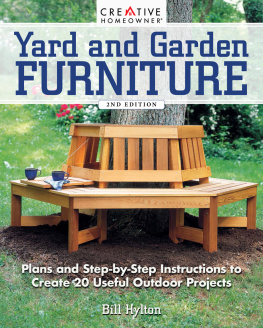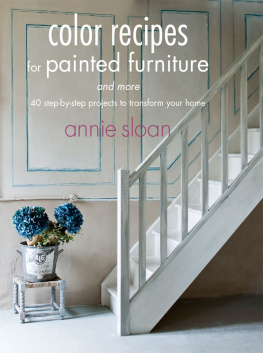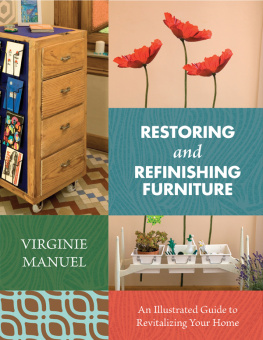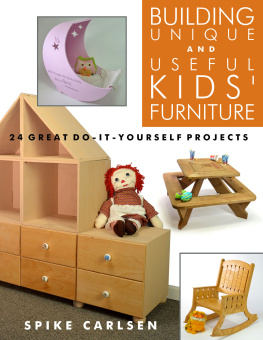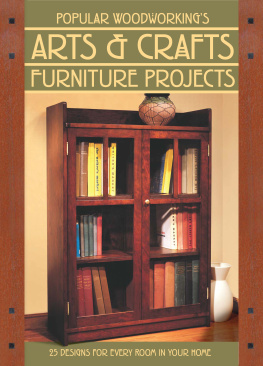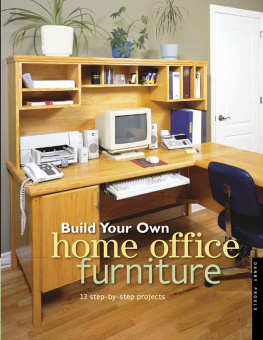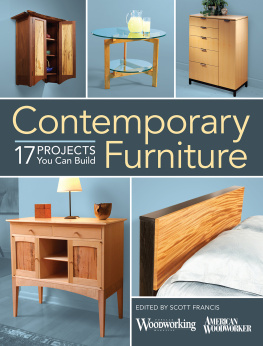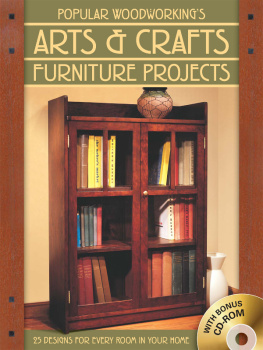We would like to thank Barnices Valentine for giving us his products to aid in the restoration process of the furniture in this book (www.valentine.es)
We would also like to thank Albert Fuentes, Haider Cano, Carole Montaigne, and Othilia Chaboche for their assistance
as well as the Natura shops (gear and materials)
Copyright 2007 by Virginie Manuel
English language translation 2015 by Skyhorse Publishing
Original Title: VAMOS A RECUPERAR MUEBLES
Virginie Manuel
Editorial Ocano, S.L.
(Barcelona, Spain)
All rights reserved. No part of this book may be reproduced in any manner without the express written consent of the publisher, except in the case of brief excerpts in critical reviews or articles. All inquiries should be addressed to Skyhorse Publishing, 307 West 36th Street, 11th Floor, New York, NY 10018.
Skyhorse Publishing books may be purchased in bulk at special discounts for sales promotion, corporate gifts, fund-raising, or educational purposes. Special editions can also be created to specifications. For details, contact the Special Sales Department, Skyhorse Publishing, 307 West 36th Street, 11th Floor, New York, NY 10018 or .
Skyhorse and Skyhorse Publishing are registered trademarks of Skyhorse Publishing, Inc., a Delaware corporation.
Visit our website at www.skyhorsepublishing.com.
10 9 8 7 6 5 4 3 2 1
Library of Congress Cataloging-in-Publication Data
Manuel, Virginie.
[Vamos a recuperar muebles. English]
Restoring and refinishing furniture: an illustrated guide to revitalizing
your home / Virginie Manuel.
pages cm
ISBN 978-1-63450-455-3 (paperback)ISBN 978-1-63450-473-7 (ebook)
1. Furniture finishing. 2. FurnitureRepairing. I. Title.
TT199.4.M3613 2015
684.1043dc23
2015017386
Cover design by Rain Saukas
Cover photos by Bob Masters (www.bobmastersphotography.com) and Virginie Manuel (www.virginimanuel.com)
Print ISBN: 978-1-63450-455-3
Ebook ISBN: 978-1-63450-473-7
CONTENTS





Introduction
Reduce, Reuse, Recycle
Sure, showing off something new is enjoyable. A cell phone, a pair of shoes, a car, a couch, a kitchen We live in a consumers society that causes us to accumulate tons of objects, gadgets, and other junk. But as soon as an item breaks, or even just goes out of style, we stash it away or, even worse, discard it. Aggressive marketing campaigns and publicity make sure we are not tempted to repair or reuse something we already own. The slogan becomes: use, toss, and buy again.
An objects lifespan becomes shorter and shorter, purchases increase and, consequently, so does the waste generated by this endless pattern. More advanced societies have developed some noticeable linear production and consumption processes in which the excess of waste is the final result.
With this book, we would like to bring a little balance to these forces and promote the three famous Rs: Reduce consumption and its waste, Reuse (refinish) objects, and Recycle materials. These three words are the key to preserving the planet we live on.
Taking into consideration the need to adopt an individual behavior that is more respectful towards nature, the goal of this book is to show that it is very easy and cost effective to reuse and refinish used furniture that we have around the house. This way, we can break the damaging cycle of using and discarding by making small repairs and alterations inspired by imagination and creativity.
See for yourself: go to your local recycling center and look at the number of old computers, keyboards, freezers, washers, furniture, and other household items that pile up in the containers. Sure, some of them could be reused. In the case of furniture, many pieces could fulfill their purpose for many years to come with just a couple of paint touch-ups.
That is exactly what this book is about. Through a series of practical examples, we will show you, step by step, the restoration and surprising transformation of several pieces of furniture and other accessories.

Restoring a Piece of Furniture
Until recently, restoring furniture was considered to be typical of the lower social classes or eccentric idealists (like the first ecologists of the 60s), as well as fans of antiques. Nowadays, the stigma against restoring is slowly disappearing, paving the way for practices that show off aesthetic qualities and variations that new furniture simply no longer possess.
Furniture lends character and style to our nearest living spaces. As products of our daily lives, they can acquire their own personality and even feelings (a childs crib, Grandmas old sofa, Dads desk ) that can affect us in more ways than we realize. Our ancestors, who passed their furniture down from generation to generation as a precious legacy, understood this. But current price reductions and the aggressive marketing campaigns of determined warehouses have started a new trend: Redecorate your lives, they say. Using cheap, practical, and impressive designs, they tell us to buy new furniture whenever it strikes our fancy, seasonally, just like we see in the fashion world. There is a downside to this attitude. We are given the short-lived pleasure of change, briefly alleviating the heaviness of daily life. The materials, the place, the production, and method of commercialization all result in the object being a cheap product that has a short lifespan. This is the core throwaway attitude.
In contrast to this extravagant option, there is a more sustainable one based on the restoration of used furniture. Take note of its two fundamental aspects:
1. Restoration. This means returning a piece of furniture to its original state. Having to do with old and valuable furniture, restoration requires an expert hand well-versed in old or modern techniques, with a knowledge of and ability to use tools, products, and special finishes.
In this book we will tackle restoration in a superficial way in order to concentrate on a more routine and affordable method: restoration through transformation, with a mindset of promoting ecological conscientiousness and developing inventive and useful skills.

2. Transformation, or the art of changing the shape, use, or appearance of a piece of furniture. As opposed to restoring, this is about reinterpreting a piece of furniture, using its qualities and defects to create a different piece, whether the change is formal (composition), utilitarian (with regards to function), or decorative (color and texture). The transformation, as well as being practical, allows for the use of imaginative resources that will give the piece of furniture its own unique personality.




